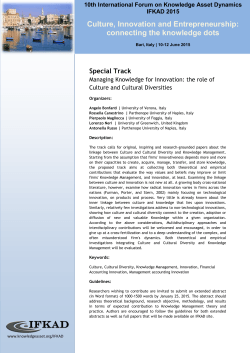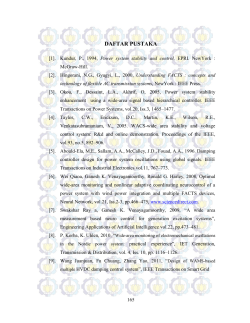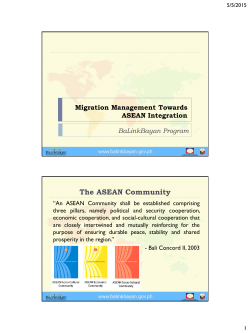
China and Regional Economic Integration For Doctoral Students in
China and Regional Economic Integration For Doctoral Students in Asia-Pacific Studies Spring 2015 (Tentative) 2/16/ 15 version Professor: Linjun Wu ljwu@nccu.edu.tw linjunwu@gmail.com Course Objectives: The purpose of this course is to introduce and investigate the implications of the rise of China for Asia-Pacific economic regionalism. The format of the course will be that of a seminar requiring substantive discussions by members of the class. Success of the class will depend on informed participation by each person, and students should keep up with the reading schedule throughout the semester. Course Requirements: (1) The course will be conducted as a seminar. Class participation is essential to the seminar format. Students are expected to attend classes or arrange absences in advance. (2) 10 weekly short article reviews. A 2-3 page critical review of assigned articles is due by Wednesday at 12:00. Reviews should include three parts: (i) Examination of authors’ backgrounds; (ii) Discussion of the articles’ most important points; (iii) Analysis of the significance of the article for current economic integration in Asia-Pacific. Reviews must be typed, double-spaced, and in line with any common academic style guide. Late reviews will either not be graded or be marked down substantially. (3) One book review. One 30-minute book presentation or research proposal will be scheduled between week 10 and week 11. (Books for the review are flexible. Please discuss your choice of books with Dr. Wu in advance.) Reviews should also include three parts. Power points should be submitted a week before the presentation. (4) One final report. One 8-page research report is expected before the end of the semester. The report must be typed, double-spaced, and in line with any common academic style guide. 1 Grades: Seminar Participation 30 % Critical Article Reviews 30 % Book Review 15 % Final Report 25 % Course Outline Week 1 2/26 Introduction The contents of China and East Asian/Asia-Pacific Economic Regionalism Week 2 3/2 Asia-Pacific/East Asian Regional Economic Integration: Overview Christopher M. Dent (2013) “Paths ahead for East Asia and Asia–Pacific regionalism,” International Affairs 89:4. Philippa Dee (2008) “The economic effects of PTAs, ” Australian Journal of International Affairs,” 62:2, 151-163. Heribert, T. Dieter (2009) “Changing patterns of regional governance: from security to political economy?” The Pacific Review, Vol. 22, No. 1, Mar, 73–90. Week 3 3/12 East Asian Regionalism T. J. Pempel (2010) ‘‘Soft Balancing, Hedging, and Institutional Darwinism: The Economic-Security Nexus and East Asian Regionalism.”, Journal of East Asian Studies, Vol. 10, Issue 2, May-Aug, 209-238. Mark Beeson (2009) “Geopolitics and the Making of Regions: The Fall and Rise of East Asia,” Political Studies, 2009, Vol, 57, 498-516. Karuhiko Kuroda (2013) “The Role of Asia in globalized Era,” Asia-Pacific Review, Vol.20. No.2, pp.101-115. Week 4 3/19 The Rise of China and the East Asian Community Hidetaka Yoshimatsu (2009) “The Rise of China and the Vision for an East Asian Community” Journal of Contemporary China, Nov2009, Vol. 18 Issue 62, pp. 745-765. Min Xia, Linan Jia and Jie Chen ( 2014) “Northeastern Asian Perceptions of China’s Rise: To What Extent Does Economic Interdependence Work? Modern China Studies , Vol. 21, No. 2. 87-132. Suisheng Zhao (2011) China’s Approaches toward Regional Cooperation in East Asia: motivations and calculations,”Journal of Contemporary China, 20(68), January, pp. 53-67. 2 China’s Multilateral Cooperation in Asia and the Pacific & Domestic Constraints on Free Trade Policy Pearson, Margaret M. (2010) “Domestic Institutional Constraints on China's Leadership in East Asian Economic Cooperation Mechanisms, “ Journal of Contemporary China, Sep. Vol. 19 Issue 66, p621-633. Ka Zeng (2010) “Multilateral versus Bilateral and Regional Trade Liberalization: Explaining China’s Pursuit of Free Trade Agreements (FTAs),”Journal of Contemporary China, 19, 66, Sep, 635-652. Week 5 3/26 Week 6 4/6 China and ASEAN in the Asia-Pacific Region Geoffrey Cockerham (2010) “Regional Integration in ASEAN: Institutional Design and the ASEAN Way,” East Asia: An International Quarterly, Vol. 27 Issue 2, 165-185. Hidetaka Yoshimatsu “ASEAN and evolving power relations in East Asia: strategies and constraints,” Contemporary Politics , Vol. 18, No. 4, December 2012, 400– 415. Week 7 4/9 China and Northeast Asian Economic Cooperation Takashi Terada, (2010) “The origins of ASEAN+6 and Japan’s initiatives: China’s rise and the agent–structure analysis,” The Pacific Review, Vol. 23 No. 1 March 2010: 71–92. T. J. Pempel(2007)“Northeast Asian Economic Integration: A Region in Flux,” Asia-Pacific Review, 14, 2. Gilbert Rozman(2007)”South Korea and Sino-Japanese Rivalry: A Middle Power’s Options within the East Asian Core Triangle,” The Pacific Review, Vol.20, No.2 (June 2007), 197-220. Week 8 4/16 US and the Asia-Pacific Region Xiaosong TANG (2012) “ The future role of the United States in the Asia-Pacific region: dead end or crossroads?” Australian Journal of International Affairs ,Vol. 66, No. 5,pp. 592605, November 2012. Takashi Terada(2013)“The US Struggles in APEC's Trade Politics: Coalition-Building and Regional Integration in the Asia-Pacific,” International Negotiation, 2013, Vol. 18 Issue 1, p.49-66. Guoyou Song and Wen Jin Yuan, “China’s Free Trade Agreement Strategies” 2012 Center for Strategic and International Studies, The Washington Quarterly, 35:4, pp. 107119. Week 9 Week 10 4/23 4/30 Mid-term week (no class) Book Reports 3 Week 11 5/7 Book Reports Week 12 5/14 ASEAN and RCEP Geoffrey B. Cockerham (2010) “Regional Integration in ASEAN: Institutional Design and the ASEAN Way,” East Asia, 27:165–185 Cheong, Inkyo and Cho, Jungran(2013)”The Evaluation of East Asian Regionalism rom APEC to RCEP, Journal of International Logistics and Trade, Vol. 11.Issue 1 (Apr 2013): 99-112. Week 13 5 / 21 TPP and Asia-Pacific Regionalism Ann Capling and John Ravenhill, “ The Multilateralising regionalism: what role for the Trans-Pacific Partnership Agreement?” Pacific Review, Vol. 24 No. 5 December 2011: 553–575. Kelsey, Meredith Lewis, (2010)The Trans-Pacific Partnership: New Paradigm or Wolf in Sheep’s Clothing?”Boston College International & Comparative Law Review, Vol. 34:27 pp.27-52. Evelyn S. Devadason (2014) “The Trans-Pacific Partnership (TPP): the Chinese perspective,” Journal of Contemporary China, 2014, Vol. 23, No. 87, 462–479. Week 14 5/28 The Political Economy of China and Taiwan’s Economic Integration Jianwei Wang (2010) “United States and Evolving Cross-Strait Relations,” Journal of Chinese Political Science, October 2010. Ching-Chang Chen (2010),”Understanding the Political Economy of Cross-Strait Security: A Missing Link,” Journal of Contemporary Chinese Political Science, 15:391–412 Evelyn S. Devadason (2010) ASEAN-China Trade Flows: moving forward with ACFTA. Journal of Contemporary China. Sep. 2010, Vol. 19 Issue 66, p653-674. Week 15 6/4 The Nature of Free Trade in the Asia Pacific? Sangkyom Kim, Innwon Park and Soonchan Park, “ A Free Trade Area of the Asia Pacific (FTAAP): Is It Desirable?” Journal of East Asian Economic Integration, Vol. 17, No. 1 (March 2013) 3-25. Richard W. X. Hu (2009) , “ APEC and Future Asia-Pacific Regional ,” Architecture, American Foreign Policy Interests, 31: 12–22. Week 16 6/11 Case Presentations (I) Week 17 6/18 Case Presentations (II) 4 Week 18 6/25 Final report week Suggested Books for Review: Nesadurai, Helen E. S. (2003) Globalization, Domestic Politics and Regionalism─ The ASEAN Free Trade Area, Routledge. Huang, Yashing (2008) Capitalism with Chinese Characteristics: Entrepreneurship and the State, Cambridge University Press. Bhagwati, Jagdish (2008) Termites in the Trading System: How Preferential Agreements Undermine Free Trade, Oxford University Press. Cai, Kevin G. (2010) The Politics of Economic Regionalism: Explaining Regional Economic Integration in East Asia, Basingstoke, England: Palgrave Macmillan. Halper, Stefan (2010) The Beijing Consensus: How China's Authoritarian Model will Dominate the Twenty-First Century, New York: Basic Books. Kang, David (2007) China Rising: Peace, Power, and Order in East Asia, Columbia University Press. Keohane, Robert (1984) After Hegemony: Cooperation and Discord in the World Political Economy, Princeton: Princeton University Press. Krasner, Stephen (1983) International Regime, Ithaca, NY: Cornell University. Maclntyre, A. J.; Pempel, T. J. and Ravenhill, J. (2008) Crisis as Catalyst: Asia’s Dynamic Political Economy, Ithaca: Cornell University Press. Overholt, William H. (2007) Asia, America, and the Transformation of Geopolitics, Cambridge University Press. (Please let Dr. Wu know in advance the books you want to review.) 5
© Copyright 2025









